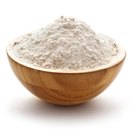
Frequently used in sauces and dressings or to saute vegetables at low heat, olive oil also serves double duty as a baking ingredient. Olive oil can be used in bread mixes, but choose your oil carefully since some oils may impart more flavor than you want. Avoid oils flavored with garlic or spices, unless you're making a savory yeast bread.
Benefits
Olive oil easily replaces vegetable or canola oil in any bread mix that calls for oil. Olive oil might cost a bit more than vegetable oil, but its health benefits probably justify the cost. Rich in monounsaturated fats, olive oil can reduce inflammation and lower the risk of heart disease. Pure extra-virgin olive oil is also a good source of vitamin E and antioxidants. Olive oil imparts a fruity, nutty flavor to quick breads and yeast breads that kids appreciate.
Method
To substitute olive oil in bread mixes, simply replace other types of oils with an equal amount of olive oil. Although mixes don't usually call for butter, you can also substitute olive oil for butter at a rate of 3 tablespoons of oil to 1/4 cup of butter. Mix thoroughly and you're done. The only time olive oil doesn't work well is when a recipe calls for you to cream butter, such as in a cake. This creaming action creates air pockets in the cake batter that rise in the oven for a light, fluffy cake. It's impossible to replicate this process with olive oil.
Type
Visit your grocery store and you'll find numerous types of olive oil on the shelves. Extra-virgin olive oil is the healthiest, but it's also the most expensive. It has a pronounced olive flavor that will permeate your bread. If you want a milder flavor, it's best to go with virgin olive oil or oil that's labeled only "olive oil," which has the most neutral flavor but the least nutritional benefits. In most baking situations, plain olive oil is the preferred choice. Save expensive extra-virgin olive oils for drizzling over salads or dipping breads.
Use
If you plan to use olive oil in all your baking, you should buy it in bulk through a grocery store or warehouse store. Keep in mind, though, that olive oil begins oxidizing as soon as you open it and can become rancid. Most oils stay fresh for up to six months. Store unopened bottles in a dark, cool pantry. For longer storage, place the bottles in the refrigerator. The oil will harden slightly but becomes soft again at room temperature.
Related Articles

Does Canola Oil Taste the Same as ...

How to Make Communion Bread Wafers

Can You Use Extra Light Olive Oil in a ...

What is Rapeseed Oil?

Cake Mix Alternative for Oil

Can You Grease a Pan With Canola Oil?

What Are Good Substitutes for Vegetable ...

Which Olive Oil Is Best to Fry With?

Can I Use Pudding Instead of Oil in ...

The Best Vegetable Oils for Deep Frying

What to Do With Pizza Dough When You're ...
Can Dry Pudding Be Added to Cake Mixes?

Canola Oil Vs. Lard in Baking
Cooking With Camellia Oil

Calories in Bread Pudding

Can Jiffy Baking Mix Be Substituted As ...

Vegan Alternatives to Lanolin in ...

Can You Substitute Yogurt for ...

Butter Substitute for Baking Scones

Substitution for Oil in Baking Brownies
References
Writer Bio
Julie Christensen is a food writer, caterer, and mom-chef. She's the creator of MarmaladeMom.org, dedicated to family fun and delicious food, and released a book titled "More Than Pot Roast: Fast, Fresh Slow Cooker Recipes."
Photo Credits
Ryan McVay/Photodisc/Getty Images